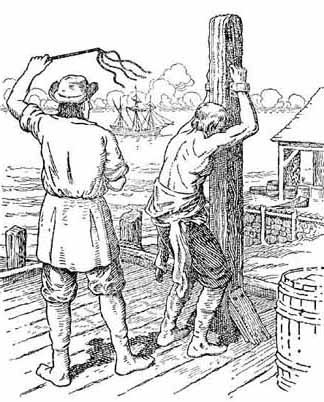From the New York Times, "Master and Servant," by Joyce Hor-Chung Lau, on 27 April 2008 -- Every schoolchild recognizes certain images of this nation’s darker side: slaves kidnapped from their native lands, shipped in disease-ridden holds, traded like animals, and then whipped and worked on America’s plantations.
Don Jordan and Michael Walsh, both of whom have made documentaries and both of whom live in London, retell that familiar tale — although the victims here are not Africans but English, Irish and Scottish people, sent to the colonies largely against their will in the 17th and 18th centuries.
“White Cargo” begins with the discovery of a 17th-century skeleton in Maryland in 2003; it turned out to be that of a boy, about 16 years old, who had suffered from tuberculosis and injuries consistent with hard labor. Presumably he had been a slave, since his body had not been properly buried, but thrown into the basement of a home near Annapolis, “in a hole under a pile of household waste.” He was northern European, probably British, one of tens of thousands of victims of a century-long practice, stretching from Boston to Barbados, that treated whites as slaves and that largely predated both the black slave trade and American independence.
Mainstream histories refer to these laborers as indentured servants, not slaves, because many agreed to work for a set period of time in exchange for land and rights. The authors argue, however, that slavery applies to any person who is bought and sold, chained and abused, whether for a decade or a lifetime. Many early settlers died long before their indenture ended or found that no court would back them when their owners failed to deliver on promises. And many never achieved freedom or the American dream they were seeking.
White Cargo: The Forgotten History of Britain's White Slaves in America; by Don Jordan and Mike Walsh
This vividly written book tells the tale from both sides of the Atlantic. Its condemnation is aimed at both American planters and the English elite, who were blinded by greed, arrogance and a desire to get rid of their “society’s sweepings.” Horribly, one of the first groups sent to America was made up of street children, ages 8 to 16, who arrived in 1619. This slave trade, which the authors say was often “dressed up in bright humanitarian clothes” for the public, later extended to beggars, Gypsies, prostitutes, dissidents, convicts and anyone else who displeased the upper classes. Founders like George Washington do not fare particularly well, but Sir John Popham and Oliver Cromwell come off worse. Benjamin Franklin is one of the few good guys.
“White Cargo” is meticulously sourced and footnoted — which is wise, given its contentious material — but it is never dry or academic. Quotations from 17th- and 18th-century letters, diaries and newspapers lend authenticity as well as color. Excerpts from wills, stating how white servants should be passed down along with livestock and furniture, say more than any textbook explanation could. The authors are not only historians, but also natural storytellers with a fine sense of drama and character.
Despite the heaviness of the subject matter, their playful way with words and love of literary allusion come through. There are kidnapping victims of the kind written about in Daniel Defoe’s “Colonel Jack,” and a tumultuous ocean voyage that may have inspired Shakespeare’s writing of “The Tempest.”
What little discussion there is about this forgotten bit of American history is sometimes linked to those with ulterior political motives, usually interested in delegitimizing current-day discourse about race or the teaching of black history. “White Cargo,” which was first published in Britain last year, has a refreshing sense of distance and neutrality. The authors take care to quote African-American sources and clearly state that they have no wish to play down the horrors of the much larger black slave trade that followed.
If anything, Jordan and Walsh offer an explanation of how the structures of slavery — black or white — were entwined in the roots of American society. They refrain from drawing links to today, except to remind readers that there are probably tens of millions of Americans who are descended from white slaves without even knowing it. [source: The New York Times; Joyce Hor-Chung Lau is an editor in the Hong Kong office of The International Herald Tribune. Copyright 2008 The New York Times Company]





No comments:
Post a Comment